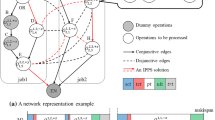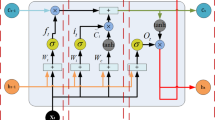Abstract
In this paper, a hybrid co-evolutionary genetic algorithm (HCGA) has been presented for determining the optimal moving paths of several nanoparticles in a complex environment. In the proposed approach, an artificial potential field (APF) has been used to determine the feasible initial paths for moving the nanoparticles. The proposed APF prepares a potential map of the environment using the initial positions of the nanoparticles and positions of the obstacles and surface roughness. The cost function used in this paper includes the area under the critical force-time diagram, surface roughness as well as path smoothness. The performed investigations indicate the importance of each of these parameters in determining the optimal paths for displacing the nanoparticles. Also, the dynamic application of crossover and mutation operators has been used to avoid premature convergence. Using the information of the potential map, two new operators have been introduced to improve the feasible and infeasible paths. Furthermore, a novel co-evolutionary mechanism for solving the multiple nanoparticle path planning problems has been presented. The proposed co-evolutionary mechanism is able to determine the best destination for each particle, optimal sequence of moves for several particles, and also the optimal path for moving each particle. Finally, the performance of the proposed HCGA has been compared with the conventional genetic algorithm (CGA) and the ant colony optimization algorithm.
Similar content being viewed by others
References
Sitti M, Hashimoto H (2000) Controlled pushing of nanoparticles: modeling and experiments. IEEE/ASME Trans Mechatron 5:199–211
A. Tafazzoli and M. Sitti (2004) Dynamic behavior and simulation of nanoparticles sliding during nanoprobe-based positioning. Presented at the Inter. Mech. Eng. congress (ASME)
A. Tafazzoli and M. Sitti (2004) Dynamic modes of nanoparticle motion during nanoprobe-based manipulation. In Proc. of IMECE’04
MH Korayem, AK Hoshiar (2013) Dynamic 3D modeling and simulation of nanoparticles manipulation using an AFM nanorobot. Robotica 1–17
Korayem MH, Hoshiar AK (2013) Modeling and simulation of dynamic modes in the manipulation of nanorods. Micro Nano Lett 8:284–286
A. Tafazzoli, C. Pawashe, and M. Sitti (2005) Atomic force microscope based two dimensional assembly of micro/nanoparticles. In Proc. of the 6th IEEE International Symposium on Assembly and Task Planning
Guthold M, Falvo MR, Matthews WG, Paulson SWS, Erie DA (2000) Controlled manipulation of molecular samples with the nanomanipulator. IEEE/ASME Trans Mechatron 5:189–198
Requicha AAG, Baur C, Bugacov A, Gazen BC, Koel B, Madhukar A et al (1988) Nanorobotic assembly of two-dimensional structures . Proceeding of IEEE Int. Conf. Robotics and Automation, Leuven, pp 3368–3374
Chen H, Xi N, Li G (2006) CAD-guided automated nanoassembly using atomic force microscopy-based nonrobotics. IEEE Trans Autom Sci Eng 3:208–217
A. Varol, I. Gunev, C. Basdogan (2006) A virtual reality toolkit for path planning and manipulation at nano-scale. Symp Haptic Interfaces Virtual Environ Teleoper Syst 485-489
Choset H, Lynch K, Hutchinson S, Kantor G, Burgard W, Kavraki LL et al (2005) Principles of robot motion: theory, algorithms, and implementation. MIT Press, Cambridge
Makaliwe JH, Requicha AAG (2001) Automatic planning of nanoparticle assembly tasks. Proceedings of the IEEE International Symposium on Assembly and Task Planning, Fukuoka
Canny JF (1998) The complexity of robot motion planning. MIT Press, Cambridge
Zhang Y, Gong D-W, Zhang J-H (2013) Robot path planning in uncertain environment using multi-objective particle swarm optimization. Neurocomputing 103:172–185
Buniyamin N, Sariff N, Ngah WAJW, Mohamad Z (2011) Robot global path planning overview and a variation of ant colony system algorithm. Int J Math Comput Simul 5:151–159
Qu H, Xing K, Alexander T (2013) An improved genetic algorithm with co-evolutionary strategy for global path planning of multiple mobile robots. Neurocomputing 120:509–517
Davoodi M, Panahi F, Mohades A, Hashemi SN (2013) Multi-objective path planning in discrete space. Appl Soft Comput 13:709–720
Tuncer A, Yildirim M (2012) Dynamic path planning of mobile robots with improved genetic algorithm. Comput Electr Eng 38:1564–1572
Liu C, Liu H, Yang J (2011) A path planning method based on adaptive genetic algorithm for mobile robot. J Inf Comput Sci 8:808–814
Yun SC, Ganapathy V, Chong LO (2010) Improved genetic algorithms based optimum path planning for mobile robot. 11th International Conference of Control Automation, Robotics and Vision (ICARCV), Singapore
Korayem MH, Esmaeilzadehha S (2012) Virtual reality interface for nano-manipulation based on enhanced images. Int J Adv Manuf Technol 63:1153–1166
Liu Y, Bharadwaj KK (2012) A hybrid artificial potential field: genetic algorithm approach to mobile robot path planning in dynamic environments. Comput Sci Converg Lect Note Electric Eng 114:325–333
Pandey HM, Chaudhary A, Mehrotra D (2014) A comparative review of approaches to prevent premature convergence in GA. Appl Soft Comput 24:1047–1077
Nicoară ES (2009) Mechanisms to avoid the premature convergence of genetic algorithms. Pet Gas Univ Ploiesti Bull Math 61:87–96
L. Davis (1985) Applying adaptive algorithms to epistatic domains. Presented at the Proceedings of the 9th international joint conference on Artificial intelligence
T. Starkweather, S. Mcdaniel, K. E. Mathias, L. Darrell Whitley, C. Whitley (1991) A comparison of genetic sequencing operators. Inter. Conf. on Genetic Algorithms ICGA
Misevicius A, Rubliauskas D (2005) Performance of hybrid genetic algorithm for the grey pattern problem. Info Technol Control 34:15–24
Misevičius A, Kilda B (2005) Comparison of crossover operators for the quadratic assignment problem. Info Technol Control 34:109–119
DE Goldberg, R Lingle (1985) Alleles, loci, and the traveling salesman problem. Proceedings of the 1st International Conference on Genetic Algorithms
Author information
Authors and Affiliations
Corresponding author
Rights and permissions
About this article
Cite this article
Korayem, M.H., Hoshiar, A.K. & Nazarahari, M. A hybrid co-evolutionary genetic algorithm for multiple nanoparticle assembly task path planning. Int J Adv Manuf Technol 87, 3527–3543 (2016). https://doi.org/10.1007/s00170-016-8683-4
Received:
Accepted:
Published:
Issue Date:
DOI: https://doi.org/10.1007/s00170-016-8683-4




